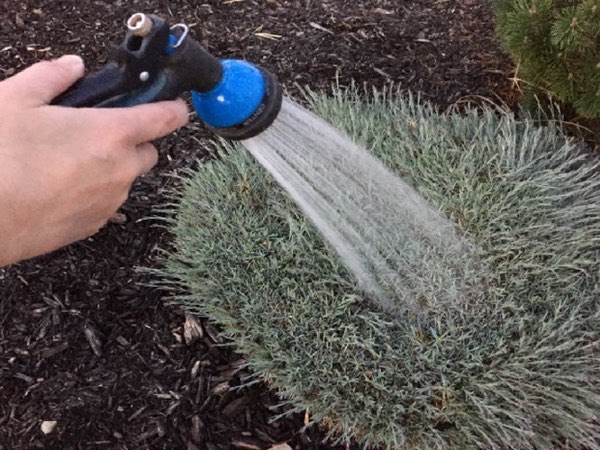Want to learn how to properly water your new plants from Showplace Garden Center? Correct watering technique is critical to ensure the success of your new plantings. Read on to learn the best techniques for watering newly planted trees and shrubs in your Northern KY landscape.
Watering your yard, garden or lawn can be tricky. You must know when and how much to water. When to water depends on the root system and how much water will be needed for the amount of soil that has dried out.
When To Water
The best way to tell when to water is by inspecting the soil in the root zone. If the soil that surrounds the plant becomes devoid of moisture, the plant will die. The best course of action is to allow the soil to dry and then water deeply. Do not water too frequently or the soil will remain soggy and wet. If the soil is too wet, it doesn’t contain enough air and the root will rot.
Although there is not one good time to water, we have found that early morning or early evening is the best time. If you water in the full sun in the heat of the day, the water may evaporate too quickly. If you water as it’s getting dark, the water left on leaves overnight is an open invitation for fungus.
Moisture Status
It is easy to determine the soil’s moisture status by examining it. Soil that breaks easily and has shiny edges that glisten is either near or above its water holding capacity. Soil that will hold your handprint when squeezed has ample water.
If the soil will not hold your handprint, it needs to be watered deeply. As a rule of thumb, you want your soil to be moist (not wet) to a depth of three to six inches.
Dry Spells And Drought
Remember, plants need more water in the hot, dry summer months. Temperatures are high and days are long. The temperature doesn’t decrease as much at night, and this is hard on all plants.
If a drought continues for a prolonged period, water the soil deeply. If there is a water shortage, or water restrictions, give the plant two thirds of the required amount and hope the drought ends.
And just because it has rained doesn’t mean your plants have enough water.
You can view current Kentucky Drought Stats at droughtmonitor.net or using the widget below:
Some of your plants might be protected by the eaves or roofline of your house and not get enough water from the rain. Same story with container plants on your porch or patio – they may get no water from the rain, so keep a sharp eye on their needs.
Watering
When applying water, be sure to use a method that will allow even distribution of the water. Be sure it isn’t given at a rate faster than the soil can absorb. In gardens, or where there is bare soil, soakers or flood type irrigation will prevent impact damage.
A good investment to make is an attachment for the end of your hose that can turn the water on and off as your proceed around your garden or yard. And watch as you tug on that hose – it’s easy to drag the hose by accident through a planting bed and injure your plants.
As the season progresses, you’ll come to know the water requirements of all the plants in your care and learn to adjust your watering for weather conditions and individual plant needs. As you start out, though, remember that too much water is as bad as too little.
